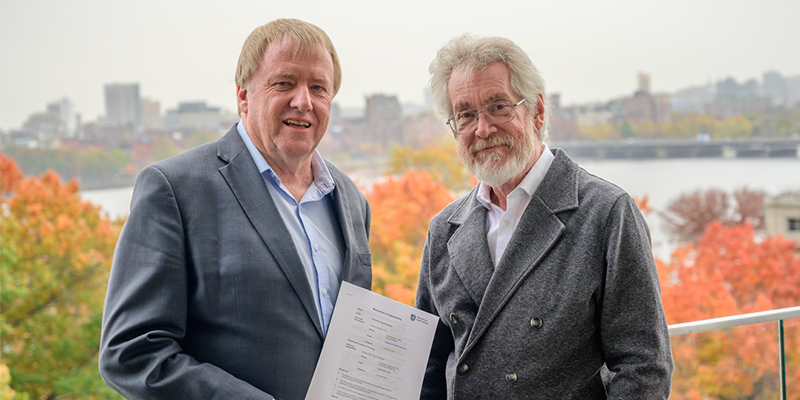New partnership with MIT to underpin data visualisation research
By Michèle Nardelli
 TECHNOLOGY AND ENGINEERING UniSA’s Professor Brenton Dansie and MIT Media Lab Entrepreneurship Program Director Professor Alex "Sandy" Pentland. Image: John Werner Photography.
TECHNOLOGY AND ENGINEERING UniSA’s Professor Brenton Dansie and MIT Media Lab Entrepreneurship Program Director Professor Alex "Sandy" Pentland. Image: John Werner Photography.UniSA has sealed the deal on an important collaboration with the Massachusetts Institute of Technology (MIT) to work on research into data visualisation and augmented reality and to support student exchange opportunities.
The two institutions signed an MOU on 30 October, outlining a framework for collaboration that boosts technology research and provides opportunities for local students to visit the US and for students from MIT to spend time at UniSA as part of their study and research.
A technology focused institution, the US-based MIT is one of the highest ranked universities in the world with an international reputation for excellence in computer science, engineering, maths, earth sciences and physics, among other fields.
The research collaboration will focus on research undertaken within MIT’s Digital Media Lab and UniSA’s Australian Research Centre for Interactive and Virtual Environments (IVE).
As a world leader in Augmented Reality (AR) and Virtual Reality (VR), the Australian Research Centre for Interactive and Virtual Environments (IVE) is a unique alignment of computer science, engineering, art, architecture and design.
Its researchers are leaders in many areas of AR and VR research including wearable computing, interface design, empathic computing, 3D visualisation, perception, and telepresence.
The agreement with UniSA has resulted from a wider collaboration with MIT, the State Government, BankSA, Optus and DSpark and relies upon involvement from Adelaide’s three universities.
The focus of the initial collaboration is the creation of South Australia’s Living Lab which will be established at Lot Fourteen.
Representing UniSA as a part of the recent State delegation to MIT, Professor Brenton Dansie says the agreement will consolidate some existing research connections with MIT and help to further develop research and student engagement.
“Two of the world’s leading researchers in AR and VR, UniSA Professors Mark Billinghurst and Bruce Thomas, have links with MIT and this new agreement will significantly enhance their efforts,” Prof Dansie says.
 At the MIT Connection Science meeting where the agreement was signed. Image: John Werner Photography.
At the MIT Connection Science meeting where the agreement was signed. Image: John Werner Photography.Other Stories
- UniSA researchers to help NASA monitor health in space
- Great career prospects for UniSA graduates, new government data shows
- Parents left in the cold when it comes to kids with autism
- New multilevel homes become heat traps in summer
- From the Vice Chancellor
- Achievements and Announcements
- World first study with drone cameras able to identify survivors
- Wastewater study pinpoints cities across the world with high drug use
- UniSA ranked top in SA for Education, Law, Business and Economics
- Opportunity for almost 200 UniSA students to study in Indo-Pacific in 2020
- Intensive course empowers women impacted by domestic violence and homelessness
- The magic that happens when a nanoengineer and immunologist collaborate
- UniSA takes reins on world first Invictus Pathways Program for Aussie veterans and first responders
- New Social Enterprise Hub to foster social innovation and entrepreneurship
- New partnership with MIT to underpin data visualisation research
- UniSA Vietnamese law student wins SA’s top honour
- The latest books from UniSA researchers
- UniSA Alumni Awards and UniSA Research Day
- Australia’s drought relief package hits the political spot but misses the bigger point
- Relive the Hawke Centre’s latest events
- Read the latest edition of unisabusiness magazine
- Read the latest edition of enterprise magazine




